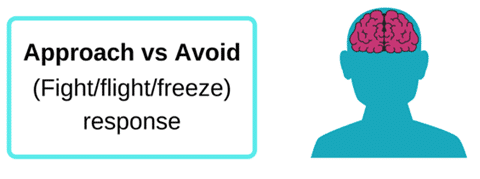67 The Neuroscience of Change
An overriding operating principle of our brain maximising reward and minimising danger. Fundamentally, this is about protecting ourselves and staying away from danger. As a result, our brain draws us towards things where we gain positive reinforcement and away from things that cause stress or danger. In terms of change and the responses we see to change, this can sometimes mean that people avoid the uncertainty or risk associated with new ideas or ways of working as our brain may be telling us this uncertainty or new approach may involve some kind of stress or negative impact to us.
Often when we sense these potential threats, we have certain physiological responses that are, in fact, adaptive and highly useful. They enable extra oxygen and glucose to get to our muscles very quickly for immediate action. The feelings experienced in such a situation are explained in the table below; and are often described as a ‘fight, flight, freeze’ response.1
In this table you can see some of the typical physiological responses in the ‘Fight, Flight or Freeze’ patterns.
| Fight, Flight or Freeze | |
|---|---|
| Response | Consequence |
| Increased heart rate | Circulates more oxygen and glucose to muscles |
| Raised blood pressure | Increases circulation |
| Palpitations | The heart is pumping harder to achieve the above |
| Rapid breathing | Increase oxygen into the body |
| Feeling of tension | Muscle tension increases in readiness for action |
| A feeling of alertness | More oxygen to the brain |
| Stomach churns | Gastrointestinal system slows down to release blood to the muscles |
| Dry mouth | As above |
| Pallor | The skin circulation is reduced to release blood to the muscles |
| Dilated pupils | Increase visual acuity ready for action |

All of this is brought about by a release of adrenaline and related chemicals into the blood stream in the face of any kind of threat that your brain perceives. It is important to note here that fear, excitement, and exercise generate similar physiological reactions but we interpret each differently depending on the sense of reward or danger our brain perceives.
We know that this interpretation of how we feel can play a vital role in how we view new ideas or respond to new events in our work and our personal lives.
Activity
Think about a time when you have experienced a fight / flight / freeze response. Try to remember the context and the situation leading up to this response in as much detail as possible.
-
bullet
What strategies did you use that helped you to make sense of the situation?
-
bullet
How might you apply these strategies when encountering other changes at work or in your personal life?
-
bullet
Jot down your thoughts in your journal. Continue to record such moments. When you have 10 or more start looking for patterns. Then start to become more and more aware of the patterns.
Remember too that these are not ‘bad’ or ‘good’ – they are ways that you react in certain situations and over time you can start to make sense of your overall approach and build strategies to leverage the beneficial elements of your responses.
Now that you know more about WHAT happens we want you to learn more about WHY these episodes happen and how you can understand more about yourself and about others.
Evolutionary Psychology
Quite clearly the fight or flight response was very useful to cave men and women who needed to fight beasts and other threats as a part of regular survival in prehistoric times. It is also useful in avoiding danger. Modern humans, though, find most of their threats come from sources other than beasts!
Threats come in the form of the need to achieve, the need for approval, security needs, financial needs, the need for love and belonging, and so on. Some of our needs are based on perception more than anything else and of course are the result of what we have learned. When these needs are not being met, we feel under threat and the physical response is the same as if being confronted by a clouded leopard.
One way of understanding our responses to modern day organisational life has been explored by David Rock who has developed the SCARF model. The model is useful in exploring our reactions to organisational stressors.
David Rock’s SCARF Model
Since early this century, neurobiologist and coach, David Rock, has been considering the way in which insights from neuroscience can inform coaching and leadership approaches. He suggests that insights into how our brain works can give clues about people’s reactions to change and the potential stressors associated with change. In the context of this unit, we are interested in understanding how changes that may come about as a result of your applied problem solving may be viewed by others in your environment.
Rock’s SCARF model suggests five social dimensions around which our brain reacts to potential stressors associated with change or adaptation, remembering that ultimately our brain’s priority is to minimise threat and maximise reward.
Those five Dimensions are:
-
bullet
Status
-
bullet
Certainty
-
bullet
Autonomy
-
bullet
Relatedness
-
bullet
Fairness
Rock’s view is that responses we see to change or transition in these domains reflect primitive human threat and reward responses of our brain.1 Understanding this potential reaction can help people prepare for and manage change approaches within teams and workplaces, for example a restructure or a change in policy.
Watch
Watch this YouTube animation for a simple overview of the SCARF model and how to apply this at work.
Now that you have a basic understanding of David Rock’s SCARF model, let’s have a look at each of the five dimensions in turn.
Activity:
SCARF is a fundamental approach to use when we are considering change and something ‘new’. Many and perhaps even most changes lead to some kinds of losses and gains felt by individuals. It is important for you to understand the sense that your stakeholders have of the losses and gains they perceive in relation to change and changes before you get too far down the track.
This is important because often we can become so involved in the potential benefits of change and innovation proposals that we can inadvertently leave key people behind. This can cause strong resentment and even active resistance and subversion, even where a new idea or opportunity may have great potential benefits.
At the very least we advise you to use this SCARF losses and gains tool to help with your thinking. This is how it works.
Numbered divider 1
Action 1: Write a short description of a change you have observed or are experiencing at the moment. You can also complete this SCARF audit for a change that you know is coming in the future. Include the suggested benefits of the change and any potential barriers and challenges you believe were in place or you might expect if the change initiative hasn’t happened as yet. Be specific about the change you are examining. This short description of the change is useful so you can be sure of the circumstances and so that you can go back later to revisit the consequences down the track.
Numbered divider 2
Action 2: Create a list of the people, teams and other entities that are involved or in some way impacted by the project or initiative you are examining. Before you start creating a huge list of stakeholders, we ask you to create what we at QUT call a ‘salience’ list. The salience list includes those who are clearly the most important to the project, who have power and influence, and those who have a strong interest in either the project being successful or who might have an interest in its failure.
We do recommend that you keep this list private! No one wants to discover that they are identified on a stakeholder list as an impediment to a project!
Numbered divider 3
Action 3: First write your name or the relevant name of the team to which you belong. Alternatively, this might be the name of the individual or the team that is proposing and driving the change initiative. Then choose the top three stakeholders from your list and add them to the SCARF audit template. You can also create more columns if you have more key stakeholders to consider. We suggest that for now you stick with three while you work on this activity for the first time.
The SCARF Losses and Gains Template
| Your name or Team Name: | Stakeholder Name 1: | Stakeholder Name 2: | Stakeholder Name 2: | |
|---|---|---|---|---|
| STATUS | ||||
| CERTAINTY | ||||
| AUTONOMY | ||||
| RELATEDNESS | ||||
| FAIRNESS | ||||
| OTHER |
Download your own fillable SCARF Losses and Gains Template
Numbered divider 4
Action 4: Now that you have competed the first four actions you are ready to start the SCARF Losses and Gains audit. Start to fill in the responses you observed or those that you anticipate might happen.
For each element of the SCARF model use this method to complete your scoring for each stakeholder. Take your time. Remember too that this is a perceptual activity. This about your perceptions of what happened or what might happen.
Here is the scoring you want to use. Fill in the spaces in the template with the arrows.
↓= Potential or actual loss
↑= Potential or actual gain
↔= Neutral or unsure about an actual or potential gain or loss
Numbered divider 5
Action 5: Now that you have finished the audit it is time to do the analysis. Again, remember that for this exercise it is entirely your perceptions of what happened or what might happen.
In terms of the analysis, you want to note who lost in what way, who gained in what way, and who wasn’t affected. What is the overall pattern and what does the overall pattern tell you? Is everyone likely to be onboard, or to resist? Is there a ‘mixed bag’? Are you facing a dream run or a total revolt! What should and could you do?
As you become more comfortable with using this approach to investigating people’s responses to the changes around them you can include those who are impacted by the changes. Please consult with your mentor and others before you embark on such an approach.
Once you have completed the audit sit back and look at your template. There are lots of ways your observations ‘tell you a story’ about what is happening.
Firstly, look for patterns across the rows and down the columns. Is there something you see here that grabs your attention?
Then look at the overall insights from your audit. Is that an overall ‘gain’ pattern; an overall ‘loss’ pattern, or some other pattern? What do you think this means for the stakeholders overall and for the change initiative?
What actions do you think the team leader might have been able to take in the short and longer term to support the team through the change process that may have enabled the process even more?
What insights does this give you about how to support yourself and your team through the change?
References
- Schmidt, N. B., Richey, J. A., Zvolensky, M. J., & Maner, J. K. (2008). Exploring human freeze responses to a threat stressor. Journal of behavior therapy and experimental psychiatry, 39(3), 292–304. https://doi.org/10.1016/j.jbtep.2007.08.002
- Wheatley, M. (2011). Leadership and the New Science: Discovering Order in a Chaotic World. San Francisco: Berrett-Koehler Publishers.
- Wheatley, M. (2011). Leadership and the New Science: Discovering Order in a Chaotic World. San Francisco: Berrett-Koehler Publishers.


